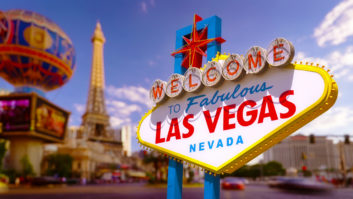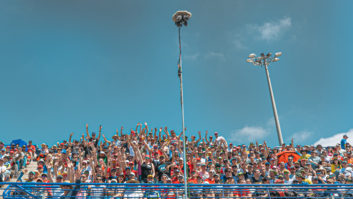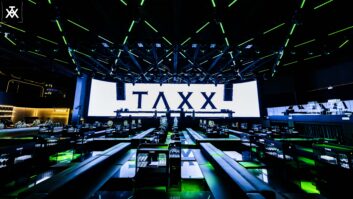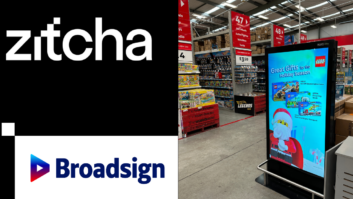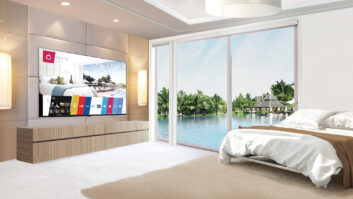A recent AVIXA report (2018 Market Opportunity Analysis Report – MOAR) stated that the hospitality sector is thriving due to a shift in consumers spending on possessions to spending on experiences. And that hospitality companies are investing in AV solutions to differentiate and compete with their rivals. As a result is the experience that hospitality companies provide for their guests improving?
“There are two sides to this story,” explains Dan Watson, senior consultant at PTS Consulting. “In the majority of cases, the bar is being raised from a user functionality point of view; simple systems to operate that always work. As a result, AV systems are becoming simpler.
“On the other hand, some clients want to maximise revenue by creating truly flexible spaces. There is often a downside to this however: in flexible spaces AV systems are unnecessarily complex, often requiring trained personnel to setup and operate the systems.”
Certainly, for most modern hotels the customer engagement process starts before the arrival of the guest, with the use of email, social media, apps and online forms allowing hotels to promote themselves and local facilities, so preparing for guest arrival – while collecting valuable data about guest preferences at the same time.
“Investment in automation and technology to enable the hotel to use information to personalise the experience that the guest has during their stay is one way that hotels can create superior levels of engagement with their guests,” says Andy Truswell CTS-D, systems integration manager, Pure Audio Visual.
“Greeting the visitor with an in-room environment tailored to match the purpose of the visit, with lighting and entertainment set accordingly, or prioritising information provided through the hotel TV around the areas of interest revealed in the pre-visit communications adds to the quality of the experience.”
Higher expectations
Part of this improvement in customer experience is due to higher consumer expectations: the expectation that they will have access to the same quality of interactivity and solutions as they do at home – and this is also driving hospitality’s need for better AV. “Guest experience is really being driven by consumer behaviour and the need to provide equivalent or better connectivity and usability as one would expect at home,” opines James Keen, group marketing manager, Tripleplay. “We’ve gone through the laggard stage of the free WiFi adoption curve and now guests have access to that – and hotels are in general offering good levels of connectivity. They are now exploring, in-depth, the methods by which they can add value and generate a ROI.”
Emma Bigg, director of Octavius RE consultants, agrees: “In hotel rooms, there is also a lot more investment in AV tech to enhance the experience – I think this is driven by the customers being more tech savvy and having access to better quality home entertainment equipment in their homes. They are also taking more time to allow for the integration of mobile devices so customers can personalise a space/room by listening to their own music or being able to view their own TV, even allow them to create a personal environment to work out in.
“Being an audiophile the biggest step-up I see is in getting audio quality right – which for so long has been a poor relation of video or visual tech. There seems to be a shift in understanding that high quality audio can transform a mediocre experience into an amazing experience without the customer really knowing.”
Operators also understand the power of networked solutions, linked together and controlled centrally and remotely. This allows content, be it music, video or lighting to be changed or refreshed very quickly so that systems become more responsive and agile. “There is more investment in channels to facilitate this responsiveness and because of this type of deployment the hardware become more scalable and easy to adapt as a space evolves,” says Bigg.
Customer expectations have certainly changed radically in recent years, putting pressure on hospitality groups to up the AV ante, regardless of what the competition are doing, or whether or not the sector is booming.
“If I have it at home and I’m paying a reasonable fee for my hotel room, then I want access to it during my stay,” comments Keen. “I think people judge by their own personal circumstances, budget and experience; so the expectations on a 5, 6 or 7 star hotel are vastly different from that of a 2, 3 or 4. In general though, people want reliable and simple to use technology. So, in our circumstances, people want good quality TV streams, they want a stable VOD delivery system and they want access to their bill via the in-room TV. Beyond that, it just needs to be a training-less, simple learning experience.”
Create your own experience
Mobile devices – BYOD for hospitality, if you will – have had a massive impact also, with customers expecting to easily integrate their smartphones and tablets with in-room tech. “Within the hotel bedroom environment, we see continued demand for the ability to connect personal mobile devices to the in-room system,” explains Trusswell. “To some extent, this is driven by the technology that we surround ourselves with at home, and many of the hotels are now having to introduce bigger, better quality in-room AV just to meet guest’s expectations.”
“We love our mobile devices, we like to be connected, we like to create our own experiences – we expect technology to feature as part of our journey through the world or sometimes have a digital detox just for fun,” adds Bigg. “We want great experiences, we want to share great experiences and ‘live our best lives’.”
But hoteliers are also looking at ways of extending interactive AV out of room, to increase customer engagement and hence improve the customer experience still further. “Many of the hotel customers that we work with at Pure seek to use AV as a tool to extend communication and engagement beyond the in-room environment to within communal areas,” says Truswell. “This can be seen in the introduction of increasingly dynamic digital signage solutions in the restaurant, lobby and transitional areas, used not only to support wayfinding and information transfer but also able to act as an interactive gateway to the access of venue services. We also see increased interest in app-driven content that encourages immediate engagement with promotional and advertising content on the screens, in much the same way, though not yet at the same scale, as we now see regularly within the retail environment.”
In communal areas the creation of areas of zoned audio offer guests the ability to wirelessly connect personal devices, and perhaps to manage the playlist for the local area, adding a layer of interaction and personalisation that increases engagement between guest and host.
Of course, this level of sophistication in technology is not yet ubiquitous, particularly in smaller hotels – many of which still offer the most basic of AV technology, especially within meeting room and conference spaces. “In meeting spaces, simple projection and flat panel installations are still in demand,” explains Truswell. “In these circumstances the critical requirement is for flexible systems that are easy for the customer to use and straightforward for the venue to manage.”
However, in larger hotel meeting and conference rooms, there is growing demand for upgrades to infrastructure to cope with digital signals and the introduction of high definition displays. “Twickenham’s South Stand Conference Centre and the InterContinental hotel at the O2 Arena are two examples of this kind of project,” continues Truswell. “An upgrade to the existing infrastructure significantly improved the quality of the services that they were able to offer their customers.”
There are a number of technologies that are key to this broadening of the customer experience in hospitality. As mentioned, there has been increased investment in technology supporting personalisation, placing guests in control of their experience. Already typical in the bedroom environment, guest-driven technology is now becoming more commonplace in reception and communal areas, with self-service check-in points, zoned audio and interactive wayfinding signage giving the guest greater control of and interaction with the environment around them.
AI, machine learning and voice control
“Across the board there is high interest in live streaming, media rich content (and technologies for relaying this content), and of course customer interactivity,” says
Watson. “When you look at the user journey – right from making the initial booking, through to the event itself – the booking and payment processes need to be seamless; automated responses and communications are to be minimised. So ultimately the creation of personalised experiences via AI and machine learning is inevitable.”
“If I have it at home and I’m paying a reasonable fee for my hotel room, then I want access to it during my stay”
James Keen, Tripleplay
“We’re seeing hotels hitting the natural refresh cycle for a lot of the early adopters of IPTV systems,” says Keen. “With it comes the need for a fully up-to-date platform, including customisable user interface and the latest in bring your own device (BYOD), bring your own content (BYOC) and, as I like to call it, bring your own subscription (BYOS).”
BYOD, of course, allows guests to access hotel entertainment content on their personal devices, streaming across the local network. BYOC allows guests to share content stored locally on their devices to the in-room TV. And BYOS allows guests to stream content from personal subscription accounts, such as Netflix, to the in-room TV using Google Chromecast.
“I see a lot of hotels and food and beverage brands really thinking about audio quality and paying attention to the subliminal effect audio content and quality can have on guest experience,” says Bigg. “I also see people looking at how digital content and music work together to create a more immersive experience. So I see an uptake in better quality speakers and amplifiers, thinking more about holistic control systems that can handle audio and video processing to bring together the technology in one easily manageable package.”
One area that is yet to take hold is voice control and AI. It surely won’t be long before it is as much a part of the hospitality experience as the welcome screen on the bedroom TV, but it isn’t quite there yet. “Voice control is still in its infancy,” explains Watson. “But I do think it has great potential within certain areas of hospitality, such as hotels and conference centres. Voice control is just another form of user interface. In its current form, it is currently much less reliable than physical user interfaces – there are lots of horror stories around misinterpretations of commands, etc. However with the use of AI, anomalies can be blocked. Security is also a hot topic when looking at voice control.”
Others are more optimistic. “Interest in the deployment of virtual assistants using voice control is accelerating as voice control becomes a more familiar feature of the home entertainment environment,” comments Truswell. “It is a clear demonstration of the influence of home-based technology on the development of AV within the hotel bedroom space.”
“Hospitality is certainly somewhere voice control will be helpful,” adds Keen. “It will improve accessibility and help enable the frictionless user experience everybody is striving for. This will undoubtedly be driven by the hotel room’s similarities to the home environment and, again, by the guest’s expectation for an experience similar to what they can achieve domestically. TVs that incorporate technologies such as Google Home Hub and Amazon Echo will start to be tried and tested in hotel environments, and we’ll probably see the emergence of more ‘human free’ check in/out hotels, which then means there is a deeper requirement for technology integration from cradle to grave.”
Yet to explore
Looking further ahead, Bigg expects to see more immersive, experiential AV technologies adding to the customer experience in the sector. “We have already seen some crazy immersive dining restaurants and bars pop up. But as the range of technology available to deliver this type of experience – which can also be enhanced by AR or VR – expands I think we’ll see more creative use of them. I am also interested to see how Haptics could make things more interesting.”
There are certainly a lot of AV tech opportunities that hospitality is yet to explore going forward. However, as hotels spending is operated on a per room, per day basis, buying decisions are likely to remain cost focused for most and adoption of new, experienced-based tech may be some way off.
“Hoteliers will sweat their assets for six or seven years in most cases,” says Keen. “So they are often cutting or bleeding edge adopters as they can’t afford to be behind the curve too soon after investment.”
This of course means that early adopting hotels may find themselves left behind and those who invest in appliance-based solutions rather than software can find they’re not offering up-to-the-minute tech quite so quickly after deployment.

